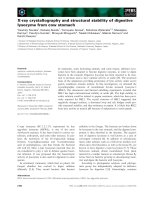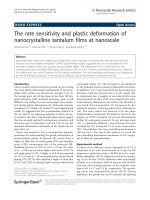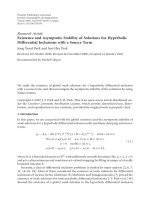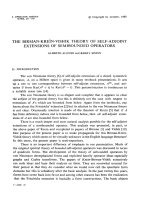Báo cáo toán học: "The Central Exponent and Asymptotic Stability of Linear Differential Algebraic Equations of Index 1" pdf
Bạn đang xem bản rút gọn của tài liệu. Xem và tải ngay bản đầy đủ của tài liệu tại đây (164.32 KB, 15 trang )
Vietnam Journal of Mathematics 34:1 (2006) 1–15
The Central Exponent and Asymptotic
Stability of Linear Differential Algebraic
Equations of Index 1
Hoang Nam
Hong Duc University, Le Lai Str., Thanh Hoa Province, Vietnam
Received October 29, 2003
Revised June 20, 2005
Abstract. In this paper, we introduce a concept of the central exponent of linear
differential algebraic equations (DAEs) similar to the one of linear ordinary differential
equations (ODEs), and use it for investigation of asymptotic stability of the DAEs.
1. Introduction
Differential algebraic equations (DAEs) have been developed as a highly topical
subject of applied mathematics. The research on this topic has been carried out
by many mathematicians in the world (see [1, 5, 7] and the references therein)
foralinearDAE
A(t)x
+ B(t)x =0,
where A(t) is singular for all t ∈ R
+
. Under certain conditions we are able to
transform it into a system consisting of a system of ordinary differential equations
(ODEs) and a system of algebraic equations so that we can use methods and
results of the theory of ODEs. Many results on stability properties of DAEs were
obtained: asymptotical and exponential stability of DAEs which are of index 1
and 2 [6], Floquet theory of periodic DAEs, criteria for the trivial solution of
DAEs with small nonlinearities to be asymptotically stable. Similar results for
autonomous quasilinear systems are given in [7].
In this paper we are intersted in stability and asymptotical properties of the
DAE
A(t)x
+ B(t)x + f (t, x)=0,
2 Hoang Nam
which can be considered as a linear DAE Ax
+ Bx = 0 perturbed by the term
f.
For this aim we introduce a concept of central exponent of linear DAEs
similar to that of ODEs (see [2]).
The paper is organized as follows. In Sec. 2 we introduce the notion of
the central exponent and some properties of central exponents of linear DAEs
of index 1. In Sec. 3 we investigate exponential asymptotic stability of linear
DAEs with respect to small linear as well as nonlinear perturbation.
2. The Central Exponent of Linear DAE of Index 1 and Its Properties
In this paper we will consider a linear DAE
A(t)x
+ B(t)x =0, (2.1)
where A, B : R
+
=(0, +∞) → L(R
m
, R
m
) are bounded continuous (m× m)ma-
trix functions, rank A(t)=r<m, N(t):=kerA(t) is of the constant dimension
m − r for all t ∈ R
+
and N(t) is smooth, i.e there exists a continuously differ-
entiable matrix function Q ∈ C
1
(R
+
,L(R
m
, R
m
)) such that Q(t) is a projection
onto N(t). We shall use the notation P = I−Q. We will always assume that (2.1)
is of index 1, i.e there exists a C
1
-smooth projector Q ∈ C
1
(R
+
,L(R
m
, R
m
)) onto
ker A(t) such that the matrix
A
1
(t):=A(t)+(B(t) − A(t)P
(t))Q(t)
(or, equivalently, the matrix G(t):=A(t)+B(t)Q(t)) has bounded inverse on
each interval [t
0
,T] ⊂ R
+
(see [5, 6]).
For definition of a solution x(t) of the DAE (2.1) one does not require x(t)
to be C
1
-smooth but only a part of its coordinates be smooth. Namely, we
introduce the space
C
1
A
(0, ∞)={x(t):R
+
→ R
m
,x(t) is continuous and P(t)x(t) ∈ C
1
}.
A function x ∈ C
1
A
(0, ∞)issaidtobeasolution of (2.1) on R
+
if the identity
A(t)
(P (t)x(t))
− P
(t)x(t)
+ B(t)x(t)=0
holds for all t ∈ R
+
.NotethatC
1
A
(0, ∞) does not depend neither on the choice
of P , nor on the definition of a solution of (2.1) above, as solution of DAEs of
index 1.
Definition 2.1. A measurable bounded function R( · ) on R
+
is called C-function
of system (2.1) if for any ε>0 there exists a positive number D
R,ε
> 0 such
that the following estimate
x(t) D
R,ε
x(t
0
)e
t
t
0
(R(τ )+ε)dτ
(2.2)
holds for all t ≥ t
0
≥ 0 and any solution x( · ) of (2.1).
The Central Exponent and Asymptotic Stability 3
The set R
A,B
of all C-functions of (2.1) is called C-class of (2.1).
For any function f : R
+
→ R we denote its upper mean value by f, i.e.
f := lim sup
T →∞
1
T
T
0
f(t)dt.
Definition 2.2. The number
Ω:= inf
R∈R
A,B
R
is called the central exponent of system (2.1).
Let V (dim V (t)=d = constant) be an invariant subspace of the solution
space of system of (2.1), i.e. V is a linear space spanned by solutions of (2.1),
V (t) is the section of V at time t. Notice that like a linear ODE, the solutions
of the DAE (2.1) form a finite-dimensional linear subspace of the space of con-
tinuous R
m
-valued functions on R
+
, understood also as a subspace of the linear
(function) space of solutions.
Definition 2.3. AfunctionR is called C-function of (2.1) with respect to V
if for any ε>0,thereexistsD
R,ε
> 0 such that for any solution x(t) ∈ V ,we
have
x(t) D
R,ε
x(t
0
)e
t
t
0
(R(τ )+ε)dτ
, for all t ≥ t
0
≥ 0.
Denote by R
V
the collection of all C-functions of V .Thenumber
Ω
V
:= inf
R
V
∈R
V
R
V
is called central exponent of (2.1) with respect to V .
Remark 2.1. If V
1
⊂ V
2
then R
V
2
⊂R
V
1
, hence Ω
V
1
Ω
V
2
.Inparticular,
Ω
V
Ω
A,B
.
Let X(t)=[x
1
(t), , x
m
(t)] be a maximal fundamental solution matrix
(FSM) of (2.1), i.e x
1
(t), , x
m
(t)aresolutionsof(2.1) and they span the solu-
tion space imP
s
(t) of (2.1) (see [5]). Here P
s
(t)=I − QA
−1
1
B is the canonical
projection of (2.1). Denote by X(t, t
0
) the maximal FSM of (2.1) normalized
at t
0
,t
0
∈ R
+
(see [1]), i.e. X(·,t
0
) is a maximal FSM satisfying the initial
condition
A(t
0
)(X(t
0
,t
0
) − I)=0.
Such a FSM exists and is the solution of the initial value problem posed with
initial value X(t
0
,t
0
)=P
s
(t
0
). Note that the normalized maximal FSMs play
the role of the Cauchy matrix for the DAEs.
Lemma 2.1. Suppose that (2.1) is a DAE of index 1 and the coefficient matrices
A(t),B(t) are continuous and bounded on R
+
. Suppose further that the matrices
4 Hoang Nam
A
−1
1
and P
are bounded on R
+
. Then the central exponent Ω of (2.1) satifies
the following equality
Ω = lim
T →∞
lim sup
n→∞
1
nT
n
i=1
ln X(iT, (i − 1)T )
=inf
T>0
lim sup
n→∞
1
nT
n
i=1
ln X(iT, (i − 1)T ). (2.3)
Proof. The proof is a simple analogue of the ODE case given in [2] (the idea is
to use boundedness of A, B, A
−1
1
,P
and a property of the matrix norm).
Note that formula (2.3) can serve as a definition of the central exponent (as
for the central exponent Ω
V
we can use the restriction of X(t, τ)toV instead
of X in the above formula). Now we will derive some properties of the central
exponent of linear DAE of index 1 and of its corresponding ODE.
Theorem 2.2. Suppose that (2.1) is a linear DAE of index 1 and the matrices
A(t), B(t), A
−1
1
, P
(t) are bounded on R
+
. Then the central exponent Ω
x
of
(2.1) is smaller than or equal to the central exponent Ω
u
of the corresponding
ODE of (2.1) under P ∈ C
1
, i.e of the ODE
u
=(P
− PA
−1
1
B
0
)u. (2.4)
Proof. Denote by X(t, s) the maximal fundamental solution matrix of (2.1)
normalized at s and by U (t, s) the Cauchy matrix of (2.4). Then X(t, s)and
U(t, s) are related by the following equality (see [1], p.18)
X(t, s)=P
s
(t)U(t, s)P (s), ∀t ≥ s ≥ 0,
hence
X(t, s) P
s
(t)U(t, s)P (s).
Since the matrices A(t), B(t), A
−1
1
(t) are bounded on R
+
, the projectors P =
A
−1
1
A, Q = I − P, Q
s
= QA
−1
1
B and P
s
= I − Q
s
are bounded on R
+
,too.Let
P
s
b
1
, P b
2
,wehave
X(t, s) b
1
b
2
U(t, s).
Therefore
lnX(t, s) ln(b
1
b
2
)+ lnU(t, s).
This implies that
n
j=1
ln X(jT,(j − 1)T ) n ln(b
1
b
2
)+
n
j=1
lnU(jT,(j − 1)T ).
Hence, by (2.3)
The Central Exponent and Asymptotic Stability 5
Ω
x
= lim
T →∞
lim sup
n→∞
1
nT
n
j=1
lnX(jT, (j − 1)T )
lim
T →∞
lim sup
n→∞
1
nT
n
j=1
lnU(jT,(j − 1)T ) + n ln(b
1
b
2
)
lim
T →∞
lim sup
n→∞
1
nT
n
j=1
lnU(jT,(j − 1)T ) =Ω
u
.
Hence Ω
x
Ω
u
. The theorem is proved.
In Definition 2.3 we introduced the notion of central exponent of a DAE
with respect to an invariant subspace of the solution space. This can certainly
be done for ODEs.
Note that the corresponding ODE (2.4) of the DAE (2.1) under some projec-
tor P (t) is defined on the whole phase space R
m
. The function space spanned by
solutions u(t) of (2.4) satisfying u(t) ∈ im P (t)fort ≥ 0, is an invariant subspace
of the solution space of that ODE. With an abuse of language we denote that
funtion space by imP . We show that the central exponent of this ODE with
respect to the function space imP is closely related to the central exponent of
the DAE (2.1) (in the sense that it characterizes better the central exponent of
the DAE (2.1)).
Let us consider the corresponding ODE of (2.1) under a projector P
u
=(P
P
s
− PG
−1
B)u. (2.5)
Similarly to Definition 2.3 we call the number
Ω
U
im P
:= inf
R∈R
im P
R,
where R
im P
is the class of C-functions of the invariant subspace im P of the
solution space of (2.5), central exponent of ODE (2.5) with respect to im P .
Clearly, Ω
U
im P
Ω
U
.
Denote by U(t, t
0
) the Cauchy matrix of (2.5).
Put
U
im P
(t, t
0
):=P (t)U(t, t
0
)P (t
0
)=U(t, t
0
)P (t
0
). (2.6)
Onecanseethat
Ω
U
im P
= lim
T →∞
lim sup
n→∞
1
nT
n−1
i=0
ln
U
imP
(i +1)T,iT
.
Denote by Ω
x
, Ω
u
and Ω
U
im P
the central exponents of (2.1), (2.5) and of
(2.5) with respect to im P.
Theorem 2.3. Suppose that (2.1) is a linear DAE of index 1 with the coefficient
matrices A(t), B(t) being continuous and bounded on R
+
. Then the following
assertions are true
6 Hoang Nam
i) If the projector P is bounded on R
+
then
Ω
U
im P
Ω
x
,
ii) If projectors P and P
s
are bounded on R
+
then
Ω
U
im P
=Ω
x
.
Proof.
i) We have the following relation between X(t, t
0
)andU(t, t
0
)(see[1])
X(t, t
0
)=P
s
(t)U(t, t
0
)P (t
0
).
Therefore
P (t)X(t, t
0
)=P (t)P
s
(t)U(t, t
0
)P (t
0
)=P (t)U(t, t
0
)P (t
0
)=U
im P
(t, t
0
).
By assumption P is bounded on R
+
, hence P b for some constant b>0.
Therefore
U
im P
P X bX.
Consequently
ln
U
im P
(jT,(j − 1)T )
ln b +lnX(jT, (j − 1)T ).
This implies that
Ω
U
im P
= lim
T →∞
lim sup
n→∞
1
nT
n
j=1
ln
U
im P
(jT,(j − 1)T )
lim
T →∞
lim sup
n→∞
1
nT
n ln b +
n
j=1
ln X(jT, (j − 1)T )
lim
T →∞
lim sup
n→∞
1
nT
n
j=1
ln X(jT, (j − 1)T ) =Ω
x
.
Thus Ω
U
imP
Ω
x
.
ii) The matrices X(t, t
0
)andU (t, t
0
) are related by the following equality (see
[1])
X(t, t
0
)=P
s
(t)U(t, t
0
)P (t
0
)=P
s
(t)U
im P
(t, t
0
).
By assumption P
s
is bounded on R
+
, hence P
s
C for constant C>0.
Therefore,
X(t, t
0
) P
s
(t)U
im P
(t, t
0
) CU
im P
.
This implies
lnX(t, t
0
) ln C +lnU
im P
(t, t
0
),
hence
n
j=1
ln X(jT, (j − 1)T ) n ln C +
n
j=1
lnU
im P
(jT,(j − 1)T .
The Central Exponent and Asymptotic Stability 7
Therefore
Ω
x
Ω
U
im P
.
By the first part of the theorem, since P is bounded on R
+
,Ω
U
im P
Ω
x
, hence
Ω
x
=Ω
U
imP
.
Corollary 2.4. Given a linear DAE of index 1 in Kronecker normal form, i.e
A(t)x
+ B(t)x =0, (2.7)
where
A(t)=
W (t)0
00
,B(t)=
B
1
(t)0
0 I
m−r
,
where W (t) is a continuous (r×r) nonsingular matrix and the matrices W
−1
(t),
B
1
(t) are continuous and bounded on R
+
. If the central exponent Ω
x
of (2.7)
is positive then Ω
x
coincides with the central exponent Ω
u
of the corresponding
ODE (2.4) of (2.7) with Q being the orthogonal projector onto ker A(t).
Proof. Since P = P
s
= I − Q are constant, Theorem 2.3 (ii) is applicable.
Corollary 2.5. Suppose that (2.1) is a linear DAE of index 1 and the matrices
A(t), B(t),G
−1
(t) are continuous and bounded on R
+
,thenΩ
x
=Ω
U
im P
.
Proof. Since A, B and G
−1
are bounded on R
+
, the matrices P = G
−1
A, P
s
=
I −QG
−1
B are bounded on R
+
, therefore by Theorem 2.3 we have Ω
x
=Ω
U
im P
.
3. The Exponential Asymptotic Stability of Linear DAEs with Re-
spect to Small Perturbations
In this section we shall use the central exponent for investigation of asymptotic
stability of DAEs. Let us consider the index 1 linear DAE (2.1).
Assume that G
−1
is bounded on R
+
. We shall be interested in the following
small nonlinear perturbations of (2.1)
A(t)x
+ B(t)x + f (t, x)=0. (3.1)
The perturbation f(t, x) is assumed to be small in the following sense
f(t, x) δ(t)x, for all t ∈ R
+
,x∈ R
m
(3.2)
for some function δ : R
+
→ R
+
. We will usually assume that δ(t) δ
0
for all
t ∈ R
+
and some constant δ
0
> 0. We assume additionally that the following
inequality
f
x
(t, x)
α
G
−1
.Q
holds for some constant 0 <α<1, where G
−1
:= sup
t∈R
+
G
−1
(t) and
Q := sup
t∈R
+
Q(t) (note that G
−1
.Q < ∞ since G
−1
is bounded on
R
+
).
Similarly to the theory of ODE we show that each solution of (3.1) is a
solution of a linear equation of the form
8 Hoang Nam
A(t)x
+ B(t)x + F (t)x =0. (3.3)
Theorem 3.1. Any nontrivial solution x
0
(t) of the perturbed system (3.1) is a
solution of some linear system of form (3.3),whereF (t)x is of the same order
of smallness as f (t, x), i.e.
F (t) δ(t), ∀t ∈ R
+
. (3.4)
Proof. From (3.2) it follows that f(t, 0) = 0, ∀t ∈ R
+
. Hence x ≡ 0 is the trivial
solution of (3.1). By the assumption on f
x
(t, x), the equation (3.1) is of index
1, hence solution of initial value problem of (3.1) is unique (see [5], Th.15, p.
36). Therefore, a nontrivial solution x
0
(t) of (3.1) does not vanish at any t ∈ R
+
.
Put
F (t, x):=
(x, x
0
(t))
x
0
(t)
2
f(t, x
0
(t)).
Clearly
F (t, x) is linear in the second variable, so that
F (t, x)=F (t)x for some
F (t). Furthermore, for any x ∈ R
m
we have
F (t)x
=
F (t, x)
xx
0
(t)
x
0
(t)
2
f(t, x
0
(t)) δ(t)x.
This implies that F (t) δ(t).
Moreover
F (t)x
0
(t)=
F (t, x
0
(t)) =
(x
0
(t),x
0
(t))
x
0
(t)
2
f(t, x
0
(t)) = f (t, x
0
(t)).
Therefore x
0
(t) is a nontrivial solution of system (3.3).
Remark 2.2. (i) We have used a restrictive condition on f
x
(t, x) to ensure that
the DAE (3.1) is of index 1. In some cases this condition can be easily verified.
Note that this condition can be replaced by a weaker condition ”the initial value
problem of (3.1) has a unique solution”.
(ii) Different solutions of (3.1) lead to different coefficient matrices of (3.3), hence
they are solutions of different linear DAEs of type (3.3).
Theorem 3.2. Suppose that (2.1) is a DAE of index 1 and matrices A(t),B(t),
A
−1
1
(t), P
(t) are continuous and bounded on R
+
, R(t) is a C-function of (2.1).
Suppose further that the perturbation term of the linear perturbed DAE
A(t)x
+ B(t)x + F (t)x =0, (3.5)
satisfies the condition
F (t) δ(t) δ
0
, (3.6)
for some δ
0
∈ R
+
.
Then for any ε>0 there exists a constant D
R,ε
depending only on R, ε and
the DAE (2.1) such that any solution x(t) of (3.5) satisfies the inequality
x(t) D
R,ε
x(t
0
)e
t
t
0
(R(τ )+ε+D
R,ε
δ(τ ))dτ
.
The Central Exponent and Asymptotic Stability 9
Moreover, for any ε>0 there exists δ
0
> 0 such that if F (t) satisfies (3.6) then
the central exponent Ω
δ
0
of (3.5) satisfies the inequality
Ω
δ
0
< Ω+ε,
where Ω is the central exponent of (2.1).
Proof. Since A
1
= A + B
0
Q,whereB
0
:= B − AP
,wehaveA
−1
1
A = P, hence
P and Q = I − P are bounded on R
+
. The DAE (3.5) is equivalent to
u
+(PA
−1
1
B
0
− P
)u + PA
−1
1
F (u + v)=0, (3.7)
v + QA
−1
1
B
0
u + QA
−1
1
F (u + v)=0, (3.8)
where u = Px, v = Qx.Forδ
0
<
1
2sup
t∈R
+
Q(t)A
−1
1
(t)
, from (3.8) we can find
for v the representation
v = −(I + QA
−1
1
F )
−1
Q
s
u − (I + QA
−1
1
F )
−1
QA
−1
1
Fu, (3.9)
where Q
s
:= QA
−1
1
B
0
.
Substituting (3.9) into (3.7) we get
u
+(PA
−1
1
B
0
− P
)u + PA
−1
1
F [I − (I + QA
−1
1
F )
−1
Q
s
− (I + QA
−1
1
F )
−1
QA
−1
1
F ]u =0.
This is a linear ODE with bounded continuous coefficients, hence it has a unique
solution of the initial value problem. Therefore, the system (3.7) - (3.8) has a
unique solution of the initial value problem.
Moreover, from (3.8) we have
v Q
s
u +QA
−1
1
F (u + v) Q
s
u +QA
−1
1
δ
0
(u + v),
hence for δ
0
<
1
2sup
t∈R
+
Q(t)A
−1
1
(t)
we have
v
Q
s
+ QA
−1
1
δ
0
1 −QA
−1
1
δ
0
u <
Q
s
+1/2
1 −QA
−1
1
δ
0
u C
1
u, (3.10)
where
C
1
:= sup
t∈R
+
(2Q
s
+1)≥
Q
s
+1/2
1 − 1/2
≥
Q
s
+1/2
1 −QA
−1
1
δ
0
≥
Q
s
+ QA
−1
1
δ
0
1 −QA
−1
1
δ
0
.
Using (3.10) we have
PA
−1
1
F (u + v)
PA
−1
1
F (u + v) PA
−1
1
(1 + C
1
)δu kδu
where k := sup
t∈R
+
P (t)A
−1
1
(t)(1 + C
1
) is a positive constant.
10 Hoang Nam
Put
F (t)u := P (t)A
−1
1
(t)F (t)(u + v)
= P (t)A
−1
1
(t)F (t)
I − (I + QA
−1
1
F )
−1
QA
−1
1
F − (I + QA
−1
1
F )
−1
Q
s
(t)u,
then the norm of
F (t) can be estimated as
F (t) PA
−1
1
(1 + C
1
)δ kδ kδ
0
.
Let us consider the linear ODE
u
=(P
− PA
−1
1
B
0
)u, u ∈ R
m
. (3.11)
Suppose that R
1
is a C-function of the invariant subspace im P of the solution
space of (3.11), U(t, t
0
) is the Cauchy matrix of (3.11) and u
δ
(t) is a solution of
the perturbed ODE
u
=(P
− PA
−1
1
B
0
)u − Fu (3.12)
with the initial value u
δ
(t
0
) ∈ im P(t
0
).
Notice that
F (t)u = P (t)A
−1
1
(t)F (t)
I − (I + QA
−1
1
F )
−1
QA
−1
1
F − (I + QA
−1
1
F )
−1
Q
s
(t)u
belongs to im P(t) then multiplying the differential equation (3.12) by Q we have
Qu
= QP
u, (Qu)
= Q
(Qu),
hence, if the initial condition of (3.12) satisfies Q(t
0
)u
δ
(t
0
) = 0 then the solution
u
δ
(t) of (3.12) satisfies the condition Q(t)u
δ
(t) = 0, i.e u
δ
(t) belongs to im P (t).
By the solution formula of an nonhomogeneous linear ODE, we have
u
δ
(t)=U(t, t
0
)u
δ
(t
0
) −
t
t
0
U(t, s)F (s)u
δ
(s)ds.
Scaling this equation by P(t) and taking norms, we obtain
u
δ
(t) P (t)U(t, t
0
)u
δ
(t
0
) +
t
t
0
P (t)U(t, s)F (s)u
δ
(s)ds.
Let U(t, t
0
)=[u
1
(t), , u
m
(t)]. Put for i =1, , m
u
i
(t):=P (t)u
i
(t) ∈ im P (t),
v
i
(t):=u
i
(t) − u
i
(t) ∈ ker P(t).
Since R
1
is a C-function of the invariant subspace im P of the solution space
of (3.11), for any ε>0, there exists a positive constant D
R
1
,ε
depending on R
1
and ε such that for all 0 t
0
t we have
The Central Exponent and Asymptotic Stability 11
P (t)U(t, t
0
) D
R
1
,ε
e
t
t
0
(R
1
(τ )+ε)dτ
,
therefore
u
δ
(t) D
R
1
,ε
e
t
t
0
(R
1
(τ )+ε)dτ
u
δ
(t
0
) + D
R
1
,ε
k
t
t
0
e
t
s
(R
1
(τ )+ε)dτ
δ(s)u
δ
(s)ds.
Put
y(t)=u
δ
(t)e
−
t
t
0
(R
1
(τ )+ε)dτ
,
we have
y(t) D
R
1
,ε
u
δ
(t
0
) + kD
R
1
,ε
t
t
0
δ(s)y(s)ds.
Using the Lemma of Gronwall - Bellman [4. p.108], we have
y(t) D
R
1
,ε
u
δ
(t
0
)e
kD
R
1
,ε
t
t
0
δ(s)ds
,
therefore
u
δ
(t) D
R
1
,ε
u
δ
(t
0
)e
t
t
0
R
1
(τ )+ε+kD
R
1
,ε
δ(τ )
dτ
. (3.13)
Recall that X(t, t
0
) denotes the maximal FSM of (2.1) normalized at t
0
.We
know that X(t, t
0
)andU(t, t
0
) are related by the following equality (see [1],
p.20-21)
X(t, t
0
)=P
s
(t)U(t, t
0
)P (t
0
)=P
s
(t)P (t)U(t, t
0
)P (t
0
)
for all t ≥ t
0
≥ 0. Since the matrices P , P
s
are bounded on R
+
, say by a positive
constant M>0, we have
X(t, t
0
) P
s
(t) P (t)U(t, t
0
)P(t
0
)
M
2
D
R
1
,ε
e
t
t
0
(R
1
(τ )+ε)dτ
for all t ≥ t
0
≥ 0. Therefore, R
1
is a C-function of (2.1).
Conversely, let R be a C-function of (2.1) and x(t), u(t) are corresponding
solutions of (2.1) and (3.11) respectively (thus u(t) ∈ im P(t)), then we have
x(t)=P
s
(t)u(t)andu(t)=P(t)x(t). Since R(t)isaC-function of (2.1), for
any ε>0thereexistsD
R,ε
depending on R and ε such that
x(t) D
R,ε
x(t
0
)e
t
t
0
(R(τ )+ε)dτ
.
12 Hoang Nam
Therefore, since P and P
s
are bounded on R
+
by M>0, we have
u(t) = P (t)x(t) P (t)x(t) MD
R,ε
x(t
0
)e
t
t
0
(R(τ )+ε)dτ
M
2
D
R,ε
u(t
0
)e
t
t
0
(R(τ )+ε)dτ
.
This implies that R(t)isaC-function of im P(t) of (3.11). Thus, C-classes R
of (2.1) and R
U
imP
of the invariant subspace im P of the solution space of (3.11)
coincide.
Suppose that x
δ
(t) is a solution of the perturbed system (3.5) of (2.1). We
have
x
δ
(t)=P (t)x
δ
(t)+Q(t)x
δ
(t)=:u
δ
(t)+v
δ
(t),
where u
δ
(t), v
δ
(t) are solutions of (3.7) and (3.8), respectively. Because of (3.10),
v
δ
C
1
u
δ
, hence using (3.13) we have
x
δ
(t) u
δ
(t) + v
δ
(t) u
δ
(t) + C
1
u
δ
(t) =(1+C
1
)u
δ
(t)
(1 + C
1
)D
R,ε
u
δ
(t
0
)e
t
t
0
(R(τ )+ε+D
R,ε
kδ(τ ))dτ
D
R,ε
x
δ
(t
0
)e
t
t
0
(R(τ )+ε+D
R,ε
δ(τ ))dτ
,
where D
R,ε
:= max
t∈R
+
(1 + C
1
)MD
R,ε
,kD
R,ε
, D
R,ε
depends only on R and ε.
Thus we have for all 0 t
0
t
x
δ
(t)
x
δ
(t
0
)
D
R,ε
e
t
t
0
(R(τ )+ε+D
R,ε
δ(τ ))dτ
for any solution x
δ
(t) of (3.5). The first assertion of the theorem is proved.
Hence
X
δ
(t, t
0
) =max
x
δ
x
δ
(t)
x
δ
(t
0
)
D
R,ε
e
t
t
0
(R(τ )+ε+D
R,ε
δ(τ ))dτ
.
Moreover, R
δ
(t):=R(t)+ε+D
R,ε
δ(t)isaC-function of (3.5) for any C-function
R of (2.1) and any fixed ε>0. It is easily seen that
R
δ
R + D
R,ε
δ + ε.
For a given ε>0wechooseR such that
R<Ω+ε and δ
0
satisfying D
R,ε
δ
0
= ε
then we have
Ω
δ
R
δ
Ω+3ε.
The theorem is proved.
The Central Exponent and Asymptotic Stability 13
Now we consider again the case of nonlinear perturbation of the DAE (2.1)
A(t)x
+ B(t)x + f (t, x) = 0 (3.14)
where f(t, x) is a small nonlinear perturbation having norm δ
0
(δ
0
> 0):
f(t, x) δ(t)x,δ(t) δ
0
, f
x
(t, x)
α
G
−1
.Q
(3.15)
for all t ∈ R
+
and some 0 <α<1.
Theorem 3.3. Suppose that (2.1) is a linear DAE of index 1 and the matrices
A(t), B(t), A
−1
1
(t) and P
(t) are continuous and bounded on R
+
.Supposefur-
ther that the perturbation term f(t, x) in (3.14) satisfies condition (3.15).Then
for any ε>0 there exist δ
1
> 0 and D = D(ε) > 0 such that if δ
0
δ
1
for any
solution x(t) of (3.14) the following inequality holds
x(t) Dx(t
0
)e
(Ω+ε)(t−t
0
)
, (3.16)
where Ω is the central exponent of the linear DAE (2.1).
Proof. Let x(t) be an arbitrary solution of the perturbed system (3.14). By
Theorems 3.1 and 3.2, for a C-function R of (2.1) and any ε>0thereexistsa
constant D
R,ε
such that
x(t) D
R,ε
x(t
0
)e
t
t
0
(R(τ )+ε+D
R,ε
δ(τ ))dτ
.
Choose δ
0
=
ε
D
R,ε
,wehave
x(t) D
R,ε
x(t
0
)e
t
t
0
(R(τ )+2ε)dτ
.
Since Ω = inf
R
R, for any ε>0 we may find a C-function R such that
R<Ω+ε.
Hence
lim sup
t→∞
1
t − t
0
t
t
0
R(τ)dτ < Ω+ε,
therefore there exists M>0 such that
t
t
0
R(τ)dτ < (Ω + ε)(t − t
0
)+lnM.
This implies
x(t) D
R,ε
x(t
0
)M.e
(Ω+3ε)(t−t
0
)
.
Since ε>0 is arbitrary the theorem is proved.
14 Hoang Nam
Lemma 3.4. If B(t) −C(t)→0, then the C-classes, hence central exponents,
of the systems
A(t)x
+ B(t)x = 0 (3.17)
and
A(t)x
+ C(t)x = 0 (3.18)
coincide, provided they are both of index 1.
Proof. We rewrite the DAE (3.18) in the form
A(t)x
+ B(t)x +(C(t) − B(t))x =0
and consider it as a perturbed system of (3.17).
Since δ(t)=C(t) − B(t)→0, for any β>0, there exists D
β
> 0such
that
t
t
0
δ(τ)dτ < β(t − t
0
)+lnD
β
, for all t ≥ t
0
.
Let R(t)beaC-function of (3.17) and ε>0 be arbitrary. Then there exists a
constant D
R,ε
> 0 such that any solution x(t) of the perturbed system (3.18)
satisfies the inequality
x(t) D
R,ε
x(t
0
)e
t
t
0
(R(τ )+ε+D
R,ε
δ(τ ))dτ
D
R,ε
x(t
0
)e
t
t
0
(R(τ )+ε+D
R,ε
β)dτ
.
Since D
R,ε
β may be chosen arbitrarily small, the above inequality proves that
R(t)isaC-function of the perturbed system (3.18).
Now, by changing the role of (3.17) and (3.18) in the above argument we
have that if R(t)isaC-function of (3.18) then it is a C-function of (3.17). Thus,
the C-classes of (3.17) and (3.18) coincide. Consequently, the central exponents
of (3.17) and (3.18) coincide.
Corollary 3.5. Suppose that (2.1) is a linear DAE of index 1 and the matrices
A(t), B(t), A
−1
1
(t), P
(t) are continuous and bounded on R
+
. Suppose that the
condition (3.15) holds. If the central exponent Ω of (2.1) is negative then there
exists δ
1
> 0 such that if δ
0
<δ
1
then there exist positive numbers D, γ > 0 such
that any solution x(t) of (2.1) satisfies the inequality
x(t) Dx(0)e
−γt
, for all t ≥ 0.
Thus, the trivial solution of perturbed system (3.14) is exponentially stable.
Proof. The corollary follows immediately from (3.16) and Ω < 0.
The Central Exponent and Asymptotic Stability 15
Corollary 3.6. Suppose that (2.1) is a linear DAE of index 1 and the matrices
A(t), B(t), G
−1
(t), P
(t) are continuous and bounded on R
+
.Supposefurther
that the central exponent Ω
u
of the corresponding ODE (2.5) is negative and the
condition (3.15) is satisfied for δ
0
> 0. Then there exists δ
1
> 0, such that if
δ
0
<δ
1
the trivial solution of perturbed equation (3.14) is exponentially stable.
Proof. By Theorem 2.2 we have Ω
x
Ω
u
< 0. By Corollary 3.5, this implies
that the trivial solution of perturbed equation (3.14) is exponentially stable.
Acknowledgement. The author would like to thank Prof. Dr. Nguyen Dinh Cong for
suggesting the problem and for the help during the work on this paper.
References
1. K. Balla and R. M¨arz, Linear differential algebraic equations of index 1 and their
adjoint equations, Results Math. 37 (2000) 13–35.
2. B. Ph. Bylov, E. R. Vynograd, D. M. Grobman, and V. V. Nemytxki, Theory of
Lyapunov Exponents, Nauka, Moscow, 1966 (in Russian).
3. N. D. Cong and H. Nam, Lyapunov’s inequality for linear differential algebraic
equation, Acta Math. Vietnam. 28 (2003) 73–88.
4. B. P. Demidovich Lectures on Mathematical Theory of Stability,Nauka,Moscow,
1967 (in Russian).
5. E. Griepentrog and R. M¨arz, Differential Algebraic Equations and Their Numerical
Treatment, Teubner - Text Math. 88, Leipzig, 1986.
6. M. Hanke and A. Rodriguetz, Asymptotic properties of regularized differential
algebraic equation, Humboldts - Universit¨at zu Berlin, Berlin, Germany, Preprint,
N95-6, 1995.
7. C. Tischendort, On stability of solutions of autonomous index 1 tractable and
quasilinear index 2 tractable DAEs,Circuits Systems Signal Process 13 (1994) 139–
154.









